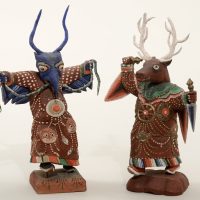The modelling of these objects as well as the harmony between their geometric decorations and subtle forms exerted a vast influence on modern art of the twentieth century, in painting, sculpture and graphic art exploring new paths at the time. Picasso’s Les Demoiselles d’Avignon, painted in 1907, traditionally considered as the first work of Cubism, unambiguously bears traces of the newly discovered art of distant cultures.
Since Picasso, tribal art has formed part of European art history, and became an inspiration in terms of form and spirit. Do ethnographers and researchers, who understand the functions that these objects have in tribal culture, see all them as artworks? Do today’s viewers see them as objects of art or interesting ethnographic artefacts from a barely known, remote world? These are the essential questions explored by the exhibition titled Perspectives – Art and Ethnography.
The explorations starting from Western Europe, the colonisations, and the encounters with exotic cultures gradually redrew the worldview of European people from the 15th century onward. During this process, the artefacts of distant peoples were regarded by collectors, scholars and museums and the public as symbols of diverse cultures. These encounters with the foreign considerably reshaped Western man’s view of humanity, society and culture. The exotic needed to be accommodated in the world.
Until the end of the 19th century, exotic objects were included in western collections mostly as ethnographies, as documents of peoples and their ways of life. Their artistic quality was not foregrounded in their interpretation. The first to include the objects of tribal art in the artistic discourse were the avant-garde and the modernists – through the concept of primitivism.
Up to the 1960s, however, any connection with and affinity towards such art was based solely on aesthetic and formal ground. The study of exotic art was a recognised part of cultural anthropology as early as the end of the 19th century, yet for a long time the approach continued to hold a peripheral status within the discipline. Since the 1980s, however, researchers have become more and more eager to ask essential questions about the cultural and universal function of art.
Current approaches of anthropology and art history are positioned between two basic standpoints. One is stating that the products of tribal art can and should be interpreted within the cultural concepts of the people itself. According to the other approach, an intercultural framework for art is needed, in which western and tribal art can be considered together.
Tribal culture and its objects now form an autonomous part of the artistic discourse. The black bodies among white walls, the anonymity of the artists, the political and poetic dimensions of collection and presentation, provide a widening spectrum of interpretations. Such interpretations are attempted in the space of this exhibition.
The exhibition was realised in cooperation with the Museum of Ethnography, Budapest.

